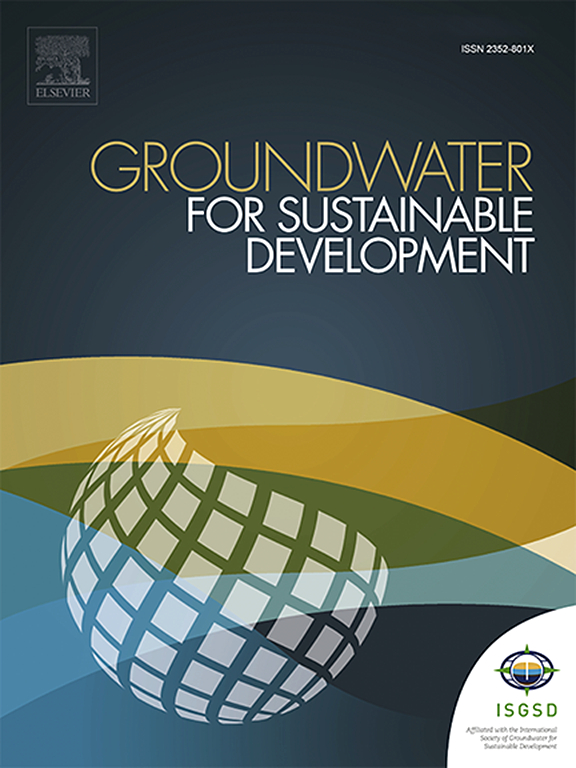Assessing seawater intrusion impact on groundwater quality in El-Omayed aquifers, Mediterranean coast, Egypt using hydrogeochemical and chemometric analyses
IF 4.9
Q2 ENGINEERING, ENVIRONMENTAL
引用次数: 0
Abstract
Groundwater, a vital freshwater source, faces threats from natural and human-induced factors, particularly seawater salinization in coastal aquifers. This study assesses the impacts of seawater intrusion and heavy metals (HMs) on groundwater quality (11 aquifers and 2 drains) in Egypt's El-Omayed area along the Mediterranean coast. Several parameters were measured including pH, electrical conductivity (EC), total dissolved solids (TDS), major ions, and seven HMs. Seawater intrusion, geochemical mechanisms, and hydrochemical faces of water, were evaluated by ion deviations (), Piper, Gibbs and Chadha plots, and various ionic ratios. The water quality indices (WQI, EWQI, and impWQI), and heavy metal pollution index were employed to assess water suitability for drinking, while EC, total hardness (TH), sodium absorption ratio (SAR), permeability index (PI), etc., were used to evaluate water suitability for irrigation. The results indicated that Na–Cl hydrochemical facies were predominant, suggesting significant salinization, and the ion-exchange mechanisms (dissolution-evaporation) influenced by seawater intrusion regulate the groundwater geochemistry. Seawater fractions (%) ranging from 0.012% to 20.89%, along with the positive mixing ratios () of and in all stations, indicates significant ion addition due to seawater intrusion. Although HM concentrations (Fe > Zn > Ni > Cu > Pb > Mn > Cd) within the WHO permissible levels for drinking, the high EC and TDS values suggest substantial saltwater intrusion. WQI, EWQI, and impWQI ranged from 86.53 to 1203.04, 89.14 to 1091.02, and 93.81 to 813.70, respectively, categorizing ∼60% of stations as “very poor,” 1–15% as “poor,” 15–23% as “moderate,” and 1% as “good”. According to FAO, about 38% of stations exhibit moderate hardness (75 < EC < 150), while 69% are permissible for irrigation (EC < 3000). The majority of samples are unsuitable with SAR>12; however, the PI% suggests suitability with PI > 75. Overall, most groundwater in the El-Omayed area is unsuitable for drinking and irrigation without pre-treatment, highlighting the urgent need for effective management and remediation to mitigate seawater intrusion and enhance water quality.

利用水文地球化学和化学计量分析评估海水入侵对埃及地中海沿岸El-Omayed含水层地下水质量的影响
地下水是一种重要的淡水资源,面临着自然和人为因素的威胁,特别是沿海含水层的海水盐碱化。本研究评估了海水入侵和重金属对地中海沿岸埃及El-Omayed地区地下水质量(11个含水层和2个排水渠)的影响。测量了pH、电导率(EC)、总溶解固体(TDS)、主要离子和7个HMs等参数。通过离子偏差(Dj)、Piper、Gibbs和Chadha图以及不同的离子比,对海水入侵、地球化学机制和水化学面进行了评价。采用水质指标(WQI、EWQI、impWQI)和重金属污染指数评价饮用水适宜性,采用EC、总硬度(TH)、钠吸收比(SAR)、渗透性指数(PI)等评价灌溉适宜性。结果表明,该地区以Na-Cl水化学相为主,表明盐渍化程度明显,海水入侵影响的离子交换机制(溶解-蒸发)调节着地下水地球化学。海水分数(fSea%)在0.012% ~ 20.89%之间,各监测站Na+和K+的正混合比(Δmi)表明海水入侵导致了明显的离子添加。虽然HM浓度(Fe >;锌比;倪祝辞铜比;Pb祝辞Mn祝辞Cd)在世界卫生组织允许的饮用水平内,高EC和TDS值表明大量的盐水入侵。WQI、EWQI和impWQI的范围分别为86.53 ~ 1203.04、89.14 ~ 1091.02和93.81 ~ 813.70,其中约60%为“非常差”,1 ~ 15%为“差”,15 ~ 23%为“中等”,1%为“好”。根据粮农组织的数据,大约38%的站点具有中等硬度(75 <;EC & lt;150),而69%被允许用于灌溉(EC <;3000)。大部分样品不适合SAR>12;然而,PI%表明与PI >;75. 总体而言,El-Omayed地区的大部分地下水未经预处理不适合饮用和灌溉,因此迫切需要进行有效的管理和补救,以减轻海水入侵,提高水质。
本文章由计算机程序翻译,如有差异,请以英文原文为准。
求助全文
约1分钟内获得全文
求助全文
来源期刊

Groundwater for Sustainable Development
Social Sciences-Geography, Planning and Development
CiteScore
11.50
自引率
10.20%
发文量
152
期刊介绍:
Groundwater for Sustainable Development is directed to different stakeholders and professionals, including government and non-governmental organizations, international funding agencies, universities, public water institutions, public health and other public/private sector professionals, and other relevant institutions. It is aimed at professionals, academics and students in the fields of disciplines such as: groundwater and its connection to surface hydrology and environment, soil sciences, engineering, ecology, microbiology, atmospheric sciences, analytical chemistry, hydro-engineering, water technology, environmental ethics, economics, public health, policy, as well as social sciences, legal disciplines, or any other area connected with water issues. The objectives of this journal are to facilitate: • The improvement of effective and sustainable management of water resources across the globe. • The improvement of human access to groundwater resources in adequate quantity and good quality. • The meeting of the increasing demand for drinking and irrigation water needed for food security to contribute to a social and economically sound human development. • The creation of a global inter- and multidisciplinary platform and forum to improve our understanding of groundwater resources and to advocate their effective and sustainable management and protection against contamination. • Interdisciplinary information exchange and to stimulate scientific research in the fields of groundwater related sciences and social and health sciences required to achieve the United Nations Millennium Development Goals for sustainable development.
 求助内容:
求助内容: 应助结果提醒方式:
应助结果提醒方式:


